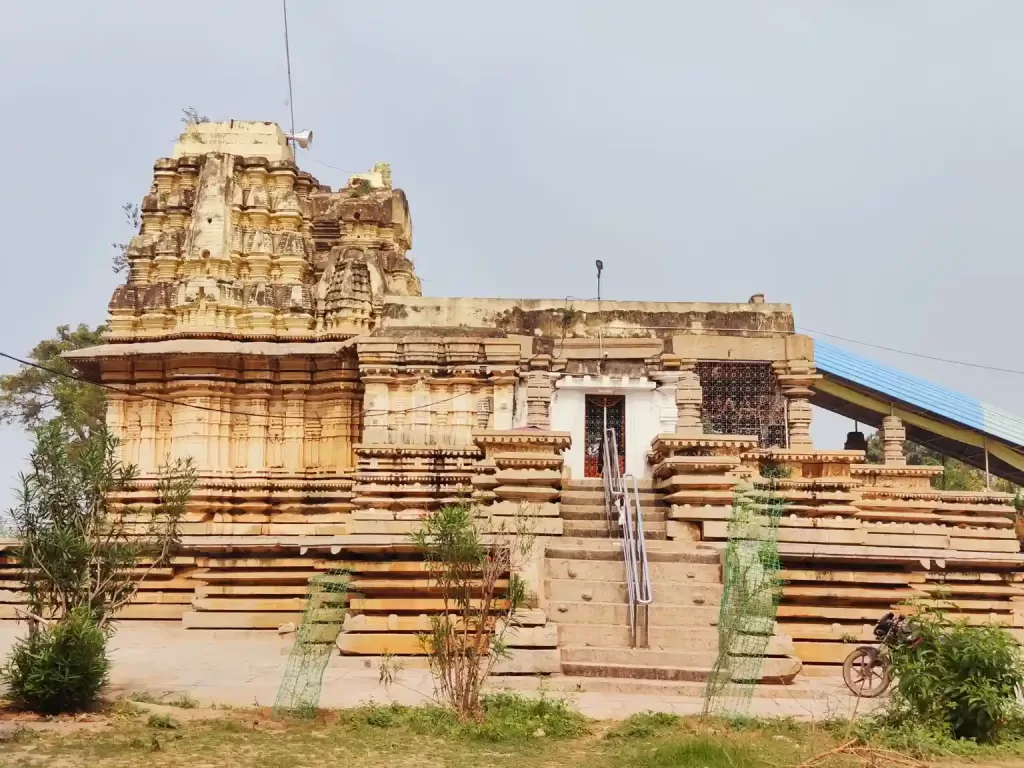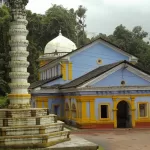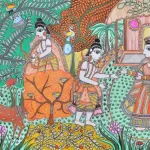Erakesvara Temple, In the village of Pillalamarri, located in the Suryapet district of Telangana (distinct from the Pillalamarri in Mahbubnagar district), three historic temples from the 12th and 13th centuries stand as remarkable examples of ancient architecture. These temples—Kacheswara, Kameswara, and Nameswara—comprise the Trikuta Alyam, Nameswara, and Erakesvara shrines.
Previously part of the Nalgonda district before the 2016 reorganization of Telangana’s districts, Pillalamarri now belongs to the Suryapet district. The village lies approximately 153 km from Hyderabad, 75 miles from Khammam Urban, and just 10 km from Suryapet.
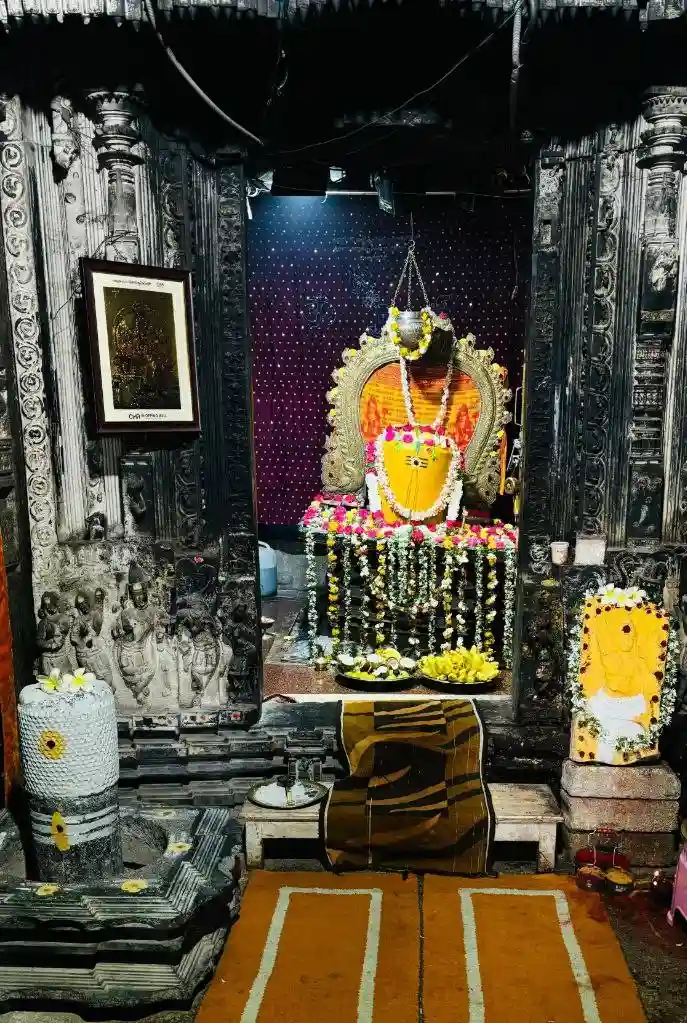
Notably, these temples, which predate the renowned Ramappa Temple, showcase the rich cultural and architectural heritage of the region.
ALSO READ: Saptakoteshwar Temple: Goa’s Iconic Shiva Shrine
Erakesvara Temple: The Recheruvula Reddy Legacy
Pillalamarri once served as the headquarters for the Recheruvula Reddy rulers. Many are familiar with Recherla Rudra Reddy, a prominent figure in the construction of Warangal’s iconic Ramappa Temple. However, the foundations of the splendid temples in Pillalamarri were laid by his paternal half-uncles and their spouses.
During the reign of the Recharla Reddy dynasty, numerous temples were constructed in the region. Unfortunately, while many of these temples were built with grandeur, only a few, including those in Pillalamarri, have withstood the test of time.
Inscriptions discovered in Pillalamarri provide insight into the genealogy of Erakasani and Recherla Bethi Reddy. The genealogical chart of the Recharla Reddy family indicates that Bethi Reddy and his wife Erakasani had two sons, Malla Reddy and Loki Reddy. However, inscriptions from Yadlapalli and Utukuru in Nalgonda District suggest a different account, stating that Loki Reddy was actually the son of Bethi Reddy’s other wife, Bollasanamma.
The Construction and Dedication of the Erakesvara Temple
This article’s primary topic is the Erakesvara temple located in Pillalamarri. Erakasani, Recharla Bethi Reddy’s wife, gave the Sthapathis the order to expertly construct this majestic sandstone structure. The queen Erakasani dedicated the Siva linga in May 1208 AD (Saka 1130, Year: Vibhava, Month: Jayestha, 3rd day of the brilliant fortnight, Day: Monday), according to inscriptions found in Pillalamarri. 2.
The queen granted land beneath the Laksma Samudram in Pillalamarri and other locations for the construction of mathas and temple upkeep on this auspicious occasion.
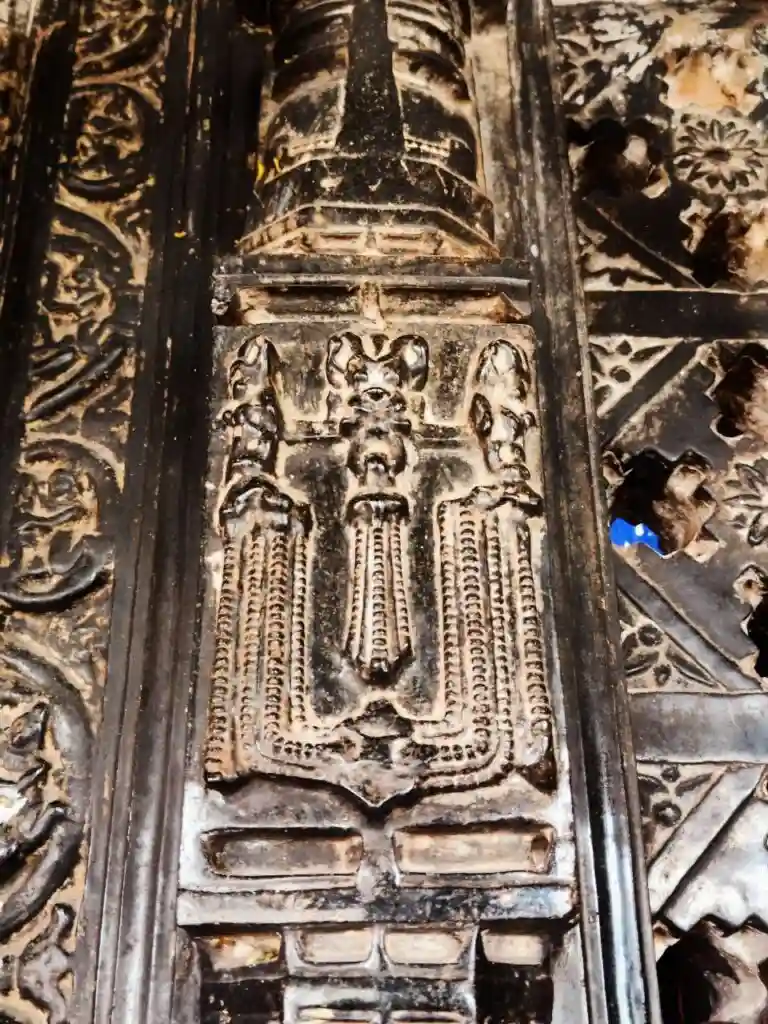
ueen is also said to have created Tripura Devi, given land for the construction of a temple, and erected Eraka Samudram (samudram here means lake) in Erkapuram on that same day.
Architectural Marvels of the Erakesvara Temple
The Shikhara (tower) above the Garbhagriha (sanctum sanctorum) is constructed in the Bhumija style of temple architecture. This tower is Ornate with so many miniature replicas of the main Shikhara. While the Shikhara itself is crafted from brick and lime, the majority of the temple is constructed from stone.
A statue of Nandi is positioned on the “Sukanasa,” a structure projecting from the Shikhara. The temple’s overall design is cruciform, and its layout, featuring a single shrine with three entrances, categorizes it as an Ekakuta temple. The interior consists of the Ranga or Nritya Mandapam (dance hall), Antarala (anteroom), and the Garbhagriha (sanctum).
The grey basalt pillars surrounding the Nritya Mandapam are adorned with mesmerizing carvings of dancers, musicians, keerthimukhas, and the Trimurti figures—Brahma, Shiva, and Vishnu. These intricate carvings enhance the beauty of the pillars.
As with many Kakatiya temples, the Antarala’s doorway features a Gaja Lakshmi motif on the lintel. A distinctive Sahasra Linga is situated on the left side of the Antarala. At the entrance to the Garbhagriha, the upper section of the door jamb is intricately carved with depictions of miniature Shikharas.
Unique Features of the Erakesvara Temple
Similar to most Kakatiya Shaivite temples, this temple originally lacked a Dwaja Sthambam (flagstaff). However, in 2009, the addition of a Dwaja Sthambam was made possible through the contributions of a few donors. Notably, the temple also does not feature a Nandi idol, the traditional vahana (vehicle) of Lord Shiva.
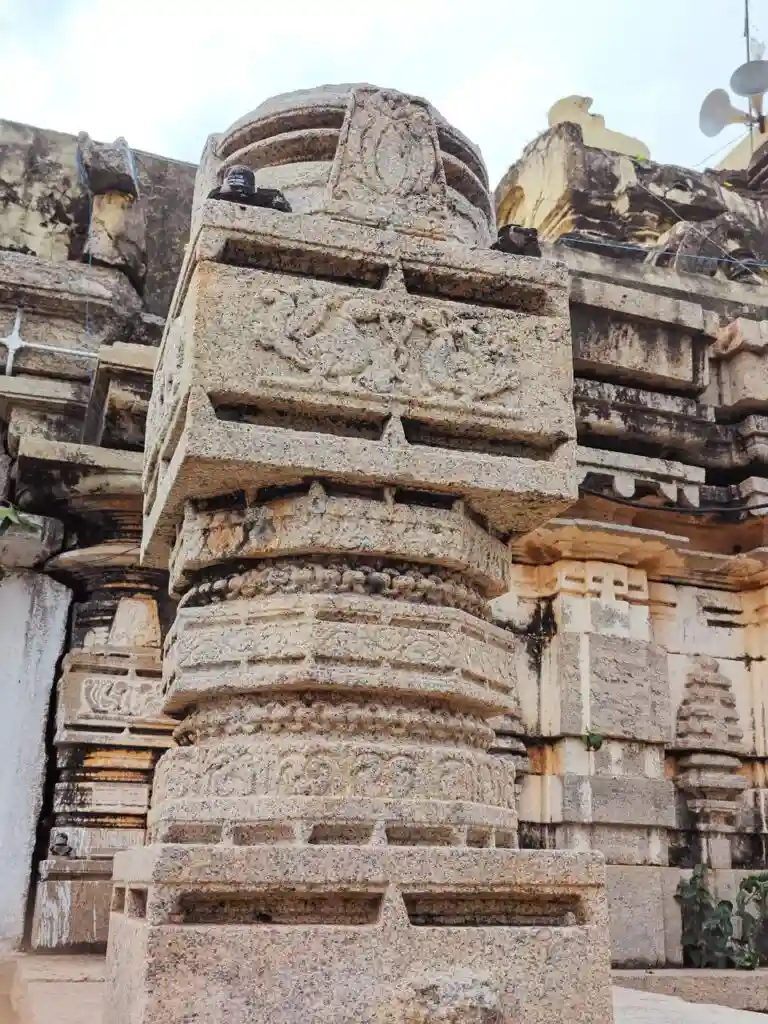
Along the Pradakshina Patha outside the temple, several small pillars are adorned with intricate carvings. These depict a variety of creatures, including lions, elephants, and the mythical Annapakshis (celestial swans), as well as detailed representations of vegetation, such as sugarcane and creepers.
Sacred Relics and Structural Insights
On the right side of the temple stands an anthill surrounded by stone slabs, believed to be quite ancient. According to the temple priest (Archaka), the local Muslim community in Pillalamarri, Suryapet, recently constructed a shrine for a Shiva Linga that was unearthed nearby.
Near the temple’s entrance lies a cuboidal-shaped inscription featuring writings and carvings of Lord Ganesha, a cow and calf, and celestial symbols of the sun and moon. The construction of a well, attributed to Queen Erakasani, took place during the foundation of Lord Erakeswara’s temple. This well remains intact and is now covered with a large circular cement slab at the entrance.
It is widely known that the renowned Ramappa Temple was constructed using the sand-box technique, which might have also been employed to strengthen the foundation of this temple. While walking around the temple, one can observe sand deposits at its base. These deposits may have resulted from the activity of ants or other insects burrowing in the area.
Queen Erakasani’s Legacy: Founding Temples, Supporting Monasteries
Additional inscriptions found at Pillalamarri reveal that Queen Erakasanamma was responsible for founding several more temples. Among these were the Komareswara and Erakesvara temples, named after her parents—Errapa (mother) and Komari Nayaka (father). It is also recorded that on the orders of Lord Erakasani, Imaturi Somaya established the Lord Betesvara temple. However, none of these temples are currently visible in the village, and it is likely that they may not withstand the ravages of time much longer.
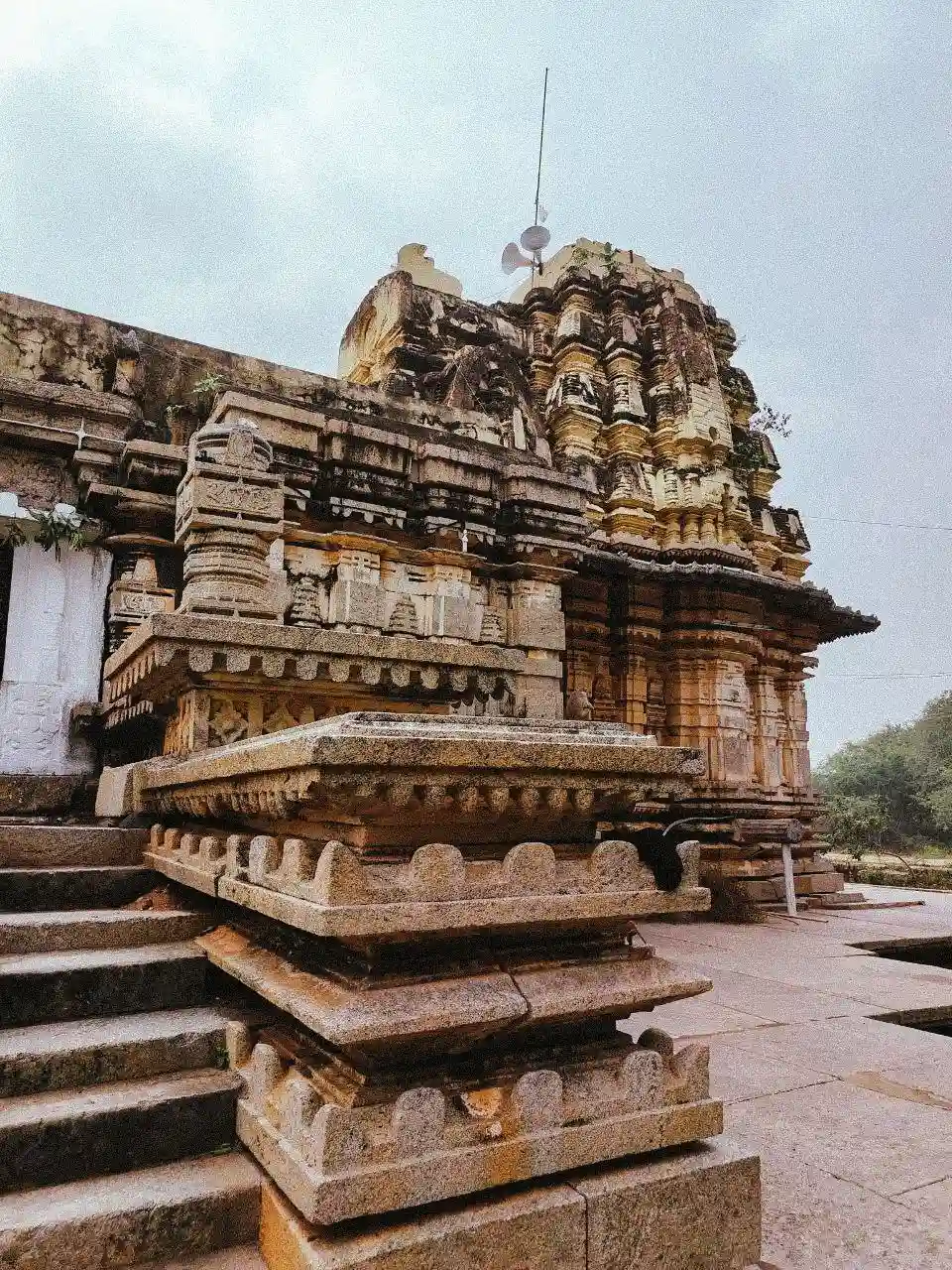
Inscriptions also reveal that Queen Erakasani contributed funds for the construction of the monastery. The records further detail how provisions were made for the chefs and students. Including the arrangement and accommodation of their clothing.
Resilience Amidst Invasions, Reinstallations, and Preservation Challenges
Ala-ud-Din Hasan Bahman Shah launched attacks on these sacred sites, leading to the desecration of the temple. Its exquisite sculptures, and statues. According to Dr. S.A.Q.
In his book “Bahman Shah: The Founder of the Bahmani Kingdom,” Husaini states that Ala-ud-Din Hasan conducted five expeditions between 1352 and 1359 A.D. With the third expedition targeting Telangana. It is believed that during this time, Bahman Shah may have invaded Telangana and defiled the local temples.
An inscription found at the Pillalamarri temple details how Erapotu Lamkam (garu) reinstalled and consecrated the Shiva Linga. Also known as Lord Erakesvara, in 1357 A.D. Erapotu. A servant of Kapaya Nayaka and the governor of Pillalamarri following the fall of the Kakatiya dynasty. Performed this sacred act. As a gesture of gratitude for the merits of his mother, father, and his chief, Kapaya Nayaka, Erapotu. Donated land to Lord Erakesvara during the reinstallation ceremony.
This temple is one of the older structures from the Kakatiya period, yet unfortunately. Its existence and history remain largely unknown to many. The Telangana State government is responsible for its preservation. But the temple needs more effective promotion to attract tourists from other regions to explore the historic sites in Pillalamarri.
I would like to thank to Dr. D Surya Kumar for his valuable guidance and the insightful information he provided.
